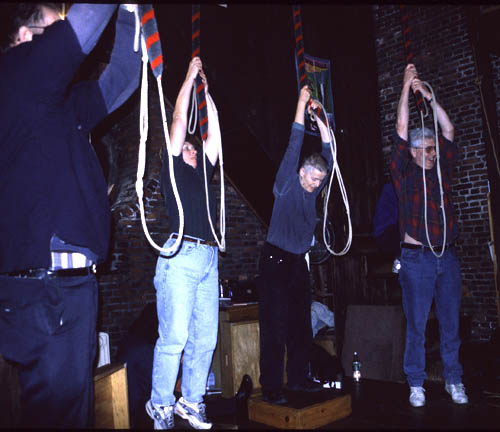
Change ringing — it’s a music tradition that mathematicians feel an unusual pull toward. Back in 2001, WBUR’s Robin Young talked with Maggie about Boston’s English change ringing for “Here and Now.”
Folk Art and Heritage in Massachusetts

Change ringing — it’s a music tradition that mathematicians feel an unusual pull toward. Back in 2001, WBUR’s Robin Young talked with Maggie about Boston’s English change ringing for “Here and Now.”
For the bagel connoisseur, there is nothing like the crunchy outside and the dense, slightly moist, texture of a freshly baked bagel. But they are becoming harder and harder to find. What passes for a bagel in most food establishments is basically a roll with a hole in the middle. Big difference. To find out why, I ventured behind the counter of my local bagel shop.
Rosenfeld’s Bagels first opened in 1972. At the time, there were many more small, individually owned bakeries in the Boston area. “It was before all the chains,” recalls owner/bagel baker Mike Lombardo, who started working at Rosenfeld’s twenty-one years ago. He has been there ever since.
Rosenfeld’s is small. There is hardly any room for the customer to stand in line to buy bagels or pick up a quart of cream cheese. Unlike chain eateries, there is no room to sit and eat. Newton has a large Jewish population and Rosenfeld’s does a brisk business. “Friday is a more religious crowd,” Mike tells me. “The Kosher people come here all the time but because of the Sabbath you have people buying challahs. It’s a very community oriented place.”
Though he himself is not Jewish, Mike and his wife Jennifer run a kosher bagel shop, with oversight by an orthodox rabbi. The bagels do not come in contact with any meat or dairy products. On Fridays, a blue tarp is draped over areas separating the bagel making area from any utensils, mixing bowls involved in making cream cheese.
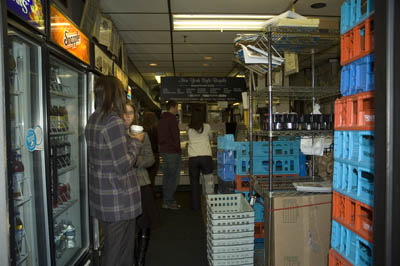
A place must really be set up to do bagels, which are a specialty item. “I learned how do make bagels from somebody who learned how to do it from people who learned how to do it in Eastern Europe in the 1920s and 1930s.” Here at Rosenfeld’s, the bagels are made the way they traditionally have been made for centuries: Bagel dough is boiled before being baked. No shortening is used (traditionally, bagels are made without any shortening). The only ingredients are high-gluten flour, water, salt, malt syrup, and yeast. Once the bagels are formed, they must “rest” for 24 hours. This allows them to rise slowly in a refrigerated environment.
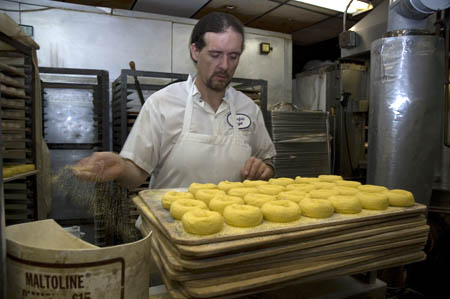

A critical step is boiling the bagels before baking them.
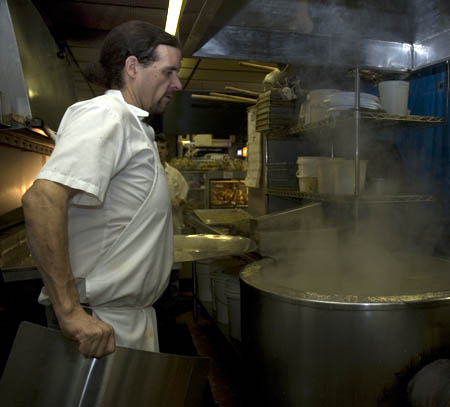
The last step is baking the bagels in the oven. This being a kosher place, the oven has been lit by an orthodox rabbi.
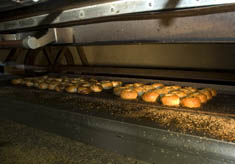

“The beauty of bagels as a bakery item is once they are baked, they’re done.” No laborious icing or decoration need be done.
Mike makes the distinction that athough the entire process of producing bagels is simple, it is not easy to do. “There are ample opportunities to screw things up at every step.”
So, next time you order a bagel at Dunkin Donuts or grab a bag of frozen bagels at the grocery store, keep in mind that they are mass-produced offsite, shortening has been added to the dough because it is so heavily machined, and they haven’t taken that obligatory dunk in boiling water before being baked. Ignorance is bliss. Once you’ve tasted a real bagel, there’s no going back.
All photos by Maggie Holtzberg. Rosenfeld’s Bagels is located at 1280 Centre Street, Newton Centre, MA. 617-527-8080
.
Addressing the American Folklore Society at the 1988 Centennial Meetings, Bess Lomax Hawes told a story about doing fieldwork, the sine qua non of the folklore profession. When she was teaching years ago, a student of hers had done an excellent term paper based on some folk curing beliefs which he had collected from an old lady in his neighborhood. By semester’s end he complained, “You taught me all about how to collect, Mrs. Hawes. What you didn’t teach me was how to stop collecting. That old lady lives on my block and every night when I come home, she runs out on the porch and says, ‘Hey boy, I just remembered another one!’ I keep trying to explain to her that my project is all finished, but she just won’t stop, and I’m starting to go up the alley when I go home just so I won’t run into her.”
“My dear young man,” Bess responded, “welcome to the grown-up world. It’s a place where real actions have real results, where real people have real feelings as well as real information. And it’s a place where old ladies actually think that people who say they are interested in what they know really are interested, and issues like course requirements and semesters and quarters are really irrelevant. You’ve gotten your A. Now you start to pay back.” (excerpt taken from Public Folkore, edited by Robert Baron and Nicholas R. Spitzer, 1992, page 68.)
Bess Lomax Hawes, a folklorist of national renown, died last Friday. Today’s Boston Globe pays tribute to her and the little piece of local folklore she left behind. During the 1940s, while raising her family in Cambridge, Bess sang with local folk groups and tried her hand at songwriting. Today’s Boston Globe story focuses on “Charlie and the MTA,” a song Bess co-wrote with her friend Jacqueline Steiner. The political ditty poked fun at the Massachusetts Transit Authority’s complicated fare system and went on to become a hit.
In addition to a career as a performer and teacher, Bess Lomax Hawes was a remarkably effective arts administrator. Rocco Landesman, current Chairman of the National Endowment for the Arts, reminds us that, during her 16-year tenure as Director of the NEA’s Folk & Traditional Arts Program, Hawes inspired her colleagues to re-imagine how a federal agency might serve often overlooked artists and communities across the nation. Hawes was largely responsible for creating this country’s version of the Japanese Living National Treasures program. The first National Heritage Fellowships were awarded in 1982 and they continue to be the country’s highest honor awarded to individual artists working in the traditional arts.
Finding, documenting, presenting, and honoring traditional artists is work that is carried out at the grassroots level. Bess was the driving force behind establishing the network of public folklorists we have in the United States today. My colleague Jeff Titon recalls the United States map Bess kept in her office: “Whenever a folklorist got a job in one of those states, a colored push pin went into the location. She used to point to the map with great pride as the number of pins, and states, and public folklorists, increased. It was as if this gentle lady was mapping an occupying army moving into positions around the country.”
Indeed it was Bess who took Jeff aside in the early 1980s and began asking him why there wasn’t a position for a state folklorist in Massachusetts. Jeff writes, “It wasn’t long before Jane Beck [founder of the Vermont Folklife Center] and I were lobbying at the state arts council, telling them that the NEA would fund a position for a state folk arts coordinator for three years, and that when the arts council saw how valuable it would be to have one, they would surely pick up the funding from then on. . . That is how the position that Maggie Holtzberg now holds with the Massachusetts Cultural Council originated. The pattern had been established before Massachusetts, and it was repeated in state after state.”
Many public folklorists, like myself, who were lucky enough to enter the field in the 1980s, were mentored by Bess. We looked to her for advice and wisdom. This is why, during the past few days, my email box has been overflowing with “Bess stories” — moving memories of this pioneering, principled, formidable, feisty, fun-spirited woman. We are often reminded of her in our daily work and will miss her presence in the world profoundly.